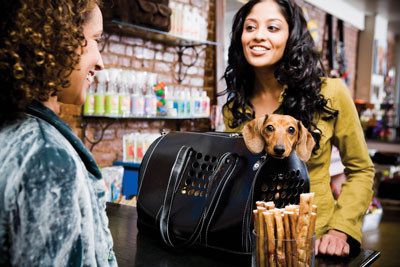Keep the Customer Satisfied
Dan Calabrese //January 5, 2015//
 It costs considerably more to attract a new customer than it does to keep one you already have. Studies have consistently shown that but it’s really common sense. An existing customer doesn’t have to be found through an aggressive and possibly expensive marketing effort. He or she is already there, a relationship that you can build upon.
It costs considerably more to attract a new customer than it does to keep one you already have. Studies have consistently shown that but it’s really common sense. An existing customer doesn’t have to be found through an aggressive and possibly expensive marketing effort. He or she is already there, a relationship that you can build upon.
Or at least that’s how it should be.
Pet retailers who know how to retain their current customers put themselves at a huge competitive advantage because new customers don’t merely replace old ones you lost. They represent growth. In addition, existing customers should be the most open to upselling propositions because they already know the value you offer.
That is especially true in pet retailing since the supplies offered by pet retailers are likely to need replenishing on a fairly regular basis. Every retained customer represents the potential for repeated sales over an extended period of time.
But it’s by no means clear that the typical pet retailer has the expertise, or is devoting the time to really achieve consistent customer retention. At its essence, customer retention is a relationship-building proposition and if that doesn’t come naturally to every retailer, there are simple steps that can help make the process work.
International business consultant Ross Beard, who works with companies both in Florida and Australia, suggest nine simple priorities to boost customer retention:
1. Set customer expectations early at a level you can exceed. Then exceed them.
2. Be the expert to your customers on the issues where they value ideas and guidance.
3. Build trust through relationships, using tactics like blogging, regular newsletters and the establishing of shared values.
4. Make use of automation to ensure that performance customers expect to see repeated are indeed repeated and with quality.
5. Embrace anticipatory service, which simply means teaching your employees to be proactive about seeking ways to serve customer needs.
6. Tie employees’ Key Performance Indicators to excellence in customer service, since most customers who go elsewhere do so because they feel they did not receive good service.
7. Make good use of social media, where customers have already indicated a willingness to hear from you and tailor information to those who are open to what you have to say.
8. Go above and beyond, doing more than the minimum required to satisfy a customer in a given situation.
9. Implement customer feedback surveys, so you really know what your customers like and don’t like, and you can use that information to keep improving.
Beard suggests data from surveys can be used in three ways to help customer retention. First, the responses of an individual customer can be used to address issues that will keep that individual from bolting. That can and should be done on a personal level if necessary. Second, a trend should develop over time with individual issues, so a pet retailer can see if it is really improving on those issues (or if it’s going in the wrong direction). Third, the broader data should tell a pet retailer which issues need the most attention.
“The fact that customer profitability tends to increase over the life of a retained customer is added incentive for businesses to allocate more resources to sharpening their customer retention strategies,” Beard wrote.
Loyalty and reward programs can also help keep existing customers in the field, provided they really reward customer loyalty while providing pet retailers with the type of data they need to better cater to customer preferences. Such programs have become so commonplace that retailers do not have to design their own, as there are plenty of developers who will license pre-fabricated programs while still allowing enough customization that a retailer can take the framework and make it truly theirs.
Of course, shoppers these days are inundated both with offers to sign up for programs and with demands—sometimes on the pushy side—from retailers that they show their cards every time they make a purchase. Pet retailers who want to make customer loyalty programs work need to walk the right side of the line so customers feel the program is really designed to reward them and not simply to help retailers collect data and push specials.
Ultimately, customers become loyal because they develop a relationship with a retailer that represents value to them. That doesn’t necessarily mean that you and the customer are best friends on a personal level, or friends at all. But it does mean that the retailer has an understanding of the customer’s needs and preferences and is prepared to meet them, sometimes before even having to be asked.
Most anyone will keep going back to a place where they feel their needs and interests are considered a priority. And forming that kind of relationship with a customer is not as hard as you think, if you know the steps to take and you follow them consistently.



















